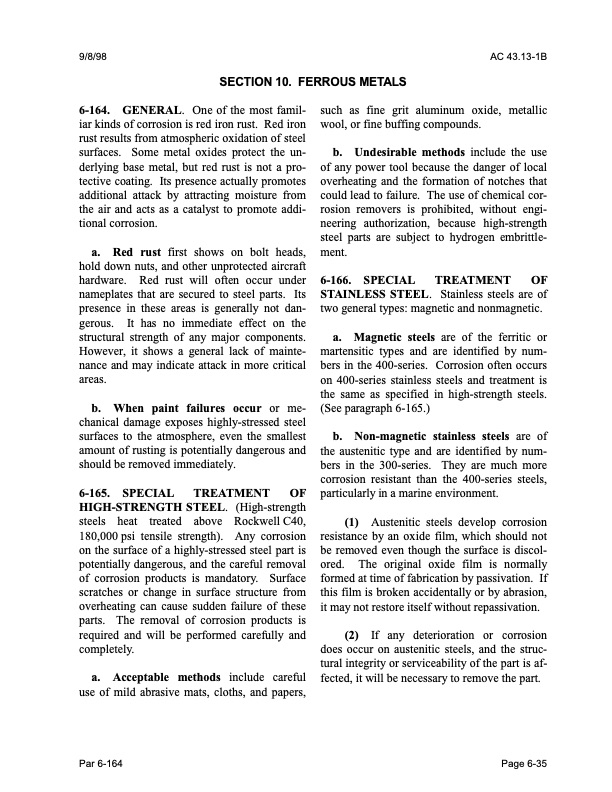
PDF Publication Title:
Text from PDF Page: 304
9/8/98 AC 43.13-1B 6-164. GENERAL. One of the most famil iar kinds of corrosion is red iron rust. Red iron rust results from atmospheric oxidation of steel surfaces. Some metal oxides protect the un derlying base metal, but red rust is not a pro tective coating. Its presence actually promotes additional attack by attracting moisture from the air and acts as a catalyst to promote addi tional corrosion. a. Red rust first shows on bolt heads, hold down nuts, and other unprotected aircraft hardware. Red rust will often occur under nameplates that are secured to steel parts. Its presence in these areas is generally not dan gerous. It has no immediate effect on the structural strength of any major components. However, it shows a general lack of mainte nance and may indicate attack in more critical areas. b. When paint failures occur or me chanical damage exposes highly-stressed steel surfaces to the atmosphere, even the smallest amount of rusting is potentially dangerous and should be removed immediately. 6-165. SPECIAL TREATMENT OF HIGH-STRENGTH STEEL. (High-strength steels heat treated above Rockwell C40, 180,000 psi tensile strength). Any corrosion on the surface of a highly-stressed steel part is potentially dangerous, and the careful removal of corrosion products is mandatory. Surface scratches or change in surface structure from overheating can cause sudden failure of these parts. The removal of corrosion products is required and will be performed carefully and completely. a. Acceptable methods include careful use of mild abrasive mats, cloths, and papers, such as fine grit aluminum oxide, metallic wool, or fine buffing compounds. b. Undesirable methods include the use of any power tool because the danger of local overheating and the formation of notches that could lead to failure. The use of chemical cor rosion removers is prohibited, without engi neering authorization, because high-strength steel parts are subject to hydrogen embrittle ment. 6-166. SPECIAL TREATMENT OF STAINLESS STEEL. Stainless steels are of two general types: magnetic and nonmagnetic. a. Magnetic steels are of the ferritic or martensitic types and are identified by num bers in the 400-series. Corrosion often occurs on 400-series stainless steels and treatment is the same as specified in high-strength steels. (See paragraph 6-165.) b. Non-magnetic stainless steels are of the austenitic type and are identified by num bers in the 300-series. They are much more corrosion resistant than the 400-series steels, particularly in a marine environment. (1) Austenitic steels develop corrosion resistance by an oxide film, which should not be removed even though the surface is discol ored. The original oxide film is normally formed at time of fabrication by passivation. If this film is broken accidentally or by abrasion, it may not restore itself without repassivation. (2) If any deterioration or corrosion does occur on austenitic steels, and the struc tural integrity or serviceability of the part is af fected, it will be necessary to remove the part. Par 6-164 Page 6-35 SECTION 10. FERROUS METALSPDF Image | AFS-640

PDF Search Title:
AFS-640Original File Name Searched:
ac_43.13-1b_w-chg1.pdfDIY PDF Search: Google It | Yahoo | Bing
5,000 BF Shipping Container Lumber Dry Kiln For Quality Lumber The 5,000 BF container kiln consists of one 40 foot high-cube aluminum shipping container... More Info
Shipping Container Lumber Dry Kilns by Global Energy Global Energy designed and developed the container kiln back in 1991. The purpose is to give access to portable sawmill owners, furniture makers, and small business the value added profit of dry kiln lumber and quality hardwoods... More Info
Vacuum Kiln Conversion Kit for Lumber and Wood Dry Kilns Convert your existing conventional dry kiln into a fast drying vacuum kiln. Similar to vacuum bagging in the boat building and aircraft industry, we have come up with a proprietary process which allows you to build a very simple vacuum kiln at a fraction of the price, and without the intensive conventional metal chamber structure... More Info
Vacuum Pump Cart System for Bagging Clamping Wood Drying and more Vacuum Cart with 2HP Pump and Dual Pistons with multiple multiplex vacuum ports and liquid reservoir... More Info
Vacuum Bagging Basics Vacuum bagging is a method of clamping, which has traditionally been used in the composites industry, but can also be used for vacuum drying materials, including wood products... More Info
| CONTACT TEL: 608-238-6001 Email: greg@globalmicroturbine.com | RSS | AMP |